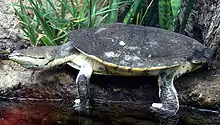Phrynops hilarii
Phrynops hilarii, commonly known as Hilaire’s toadhead turtle or Hilaire’s side-necked turtle, is a species of freshwater turtle in the family Chelidae. The species is endemic to South America.
| Phrynops hilarii | |
|---|---|
 | |
| Scientific classification | |
| Kingdom: | Animalia |
| Phylum: | Chordata |
| Class: | Reptilia |
| Order: | Testudines |
| Suborder: | Pleurodira |
| Family: | Chelidae |
| Genus: | Phrynops |
| Species: | P. hilarii |
| Binomial name | |
| Phrynops hilarii | |
| Synonyms[2][3] | |
|
List
| |
Etymology
The specific name, hilarii, is in honor of French zoologist Isidore Geoffroy Saint-Hilaire.[4]
Geographic range
P. hilarii is found in southern Brazil (Santa Catarina and Rio Grande do Sul), southward and westward into Uruguay and Argentina, and possibly also in Paraguay and Bolivia.[5]
Habitat
These turtles inhabit streams, lakes and swamps with abundant aquatic vegetation and soft bottoms.[6]
Description

Phrynops hilarii has an oval, flattened carapace, with a maximum length of approximately 40 cm, weighing approximately 5 kg. The carapace is usually dark brown, olive, or gray, with a yellow border. The head is large and flat, gray to olive above, with a pointed snout and two bicolored chin barbels There is a black band on each side of the head, which comes out of the muzzle and passes over the eyes, going up to the neck. [7][6]
Biology
This omnivorous species mainly feed on arthropods, with a preference for copepods, ostracods, and hemipterans. [8] They feed also on fish, birds, reptiles, small mammals and dead animals. It is oviparous. [5] These turtles can live for up to 37 years. [9]
Females lay twice a year, one between February and May and the other between September and December. They lay from 9 to 14 eggs, with a maximum of 32 eggs and an incubation period of approximately 150 days.
References
| Wikispecies has information related to Phrynops hilarii. |
| Wikimedia Commons has media related to Phrynops hilarii. |
- Duméril, André Marie Constant; Bibron, Gabriel (1835). Erpétologie Générale ou Histoire Naturelle Complète des Reptiles. Tome Second. Paris: Roret. 680 pp. (Platemys hilarii, new species, pp. 428-430). (in French).
- Fritz, Uwe; Havaš, Peter (2007). "Checklist of Chelonians of the World" (PDF). Vertebrate Zoology. 57 (2): 341. ISSN 1864-5755. Archived from the original (PDF) on 2010-12-17. Retrieved 29 May 2012.
- van Dijk, Peter Paul; Iverson, John B.; Shaffer, H. Bradley; Bour, Roger; Rhodin; Anders G.J. (2012). Turtles of the World, 2012 Update: Annotated Checklist of Taxonomy, Synonymy, Distribution, and Conservation Status. Chelonian Research Monographs No. 5, pp. 000.243–000.328.
- Beolens, Bo; Watkins, Michael; Grayson, Michael (2011). The Eponym Dictionary of Reptiles. Baltimore: Johns Hopkins University Press. xiii + 296 pp. ISBN 978-1-4214-0135-5. (Phrynops hilarii, p. 123).
- The Reptile Database
- Turtles of the World
- Mario R. Cabrera, Sonia E. Colantonio Ontogenetic variation of plastral spotting pattern in Phrynops hilarii (Testudines, Chelidae)
- Leandro Alcalde, Natacha Nara Derocco, and Sergio Daniel Rosset Feeding in Syntopy: Diet of Hydromedusa tectifera and Phrynops hilarii (Chelidae)
- The animal ageing and longevity database
Further reading
- Boulenger, George Albert (1889). Catalogue of the Chelonians, Rhynchocephalians, and Crocodiles in the British Museum (Natural History). New Edition. London: Trustees of the British Museum (Natural History). (Taylor and Francis, printers). x + 311 pp. + Plates I-III. (Hydraspis hilarii: p. 220, figure 59, three views of skull; p. 221, figure 60, carapace and plastron; p. 222, species description).
